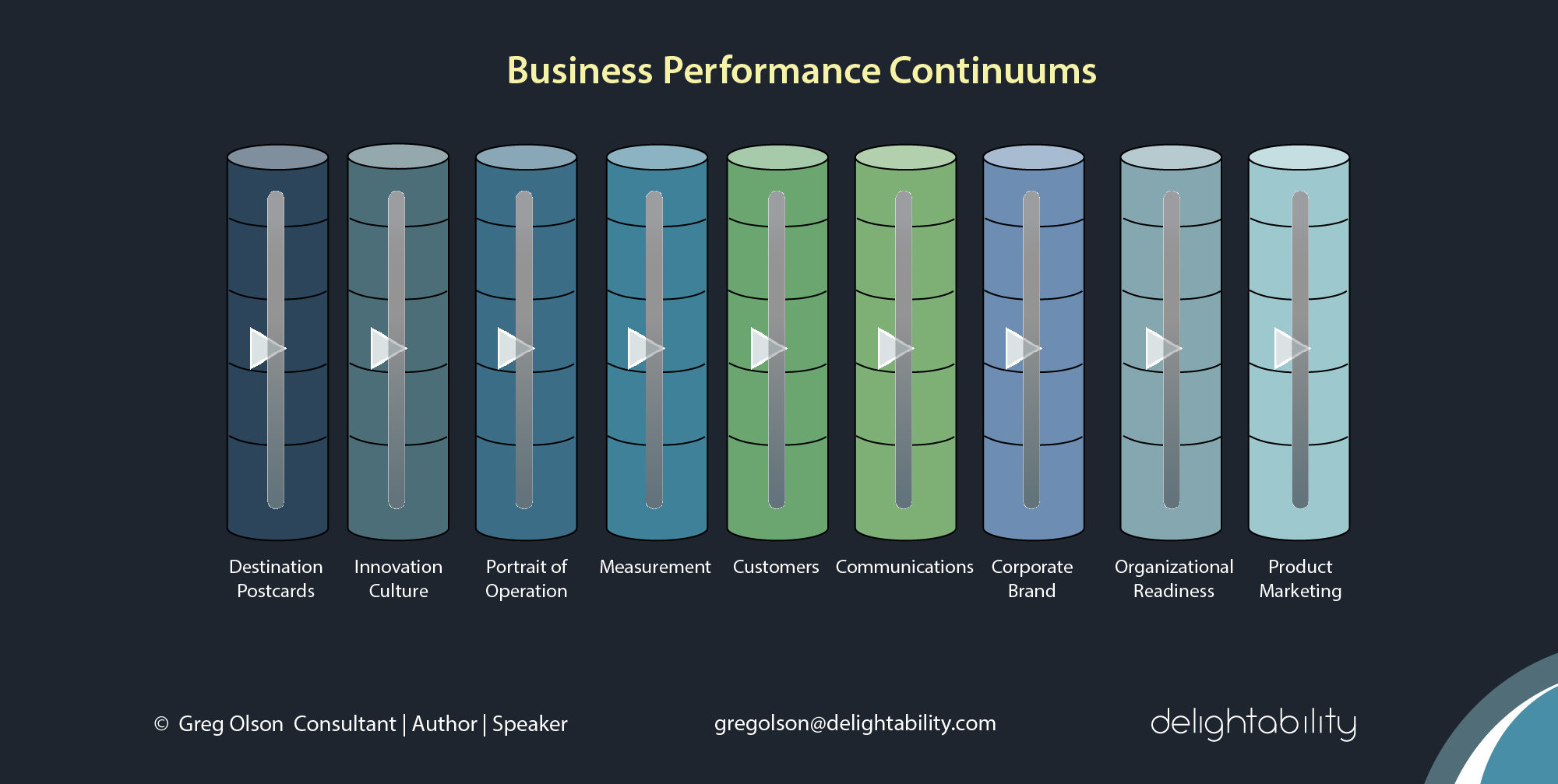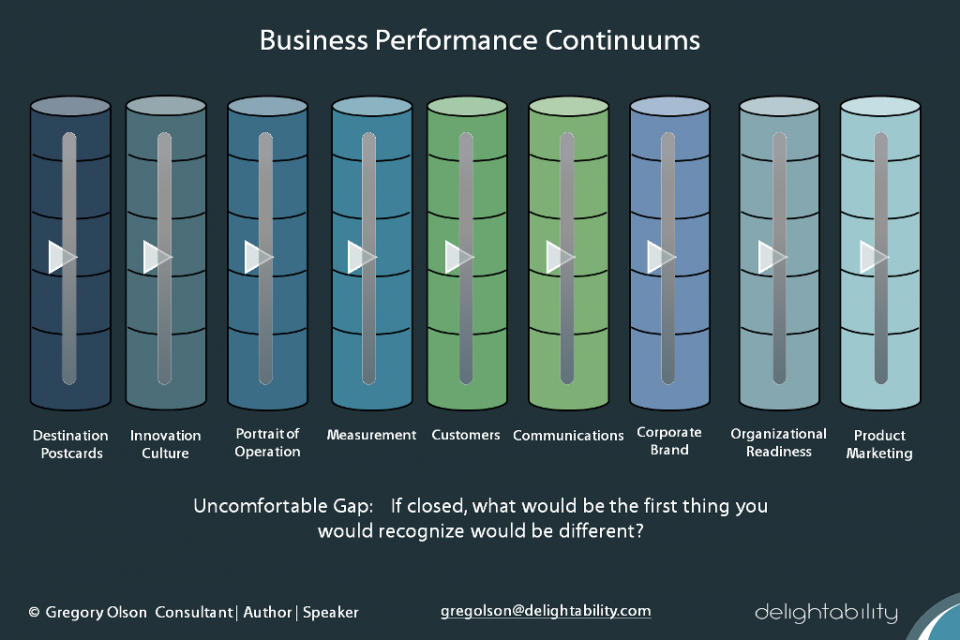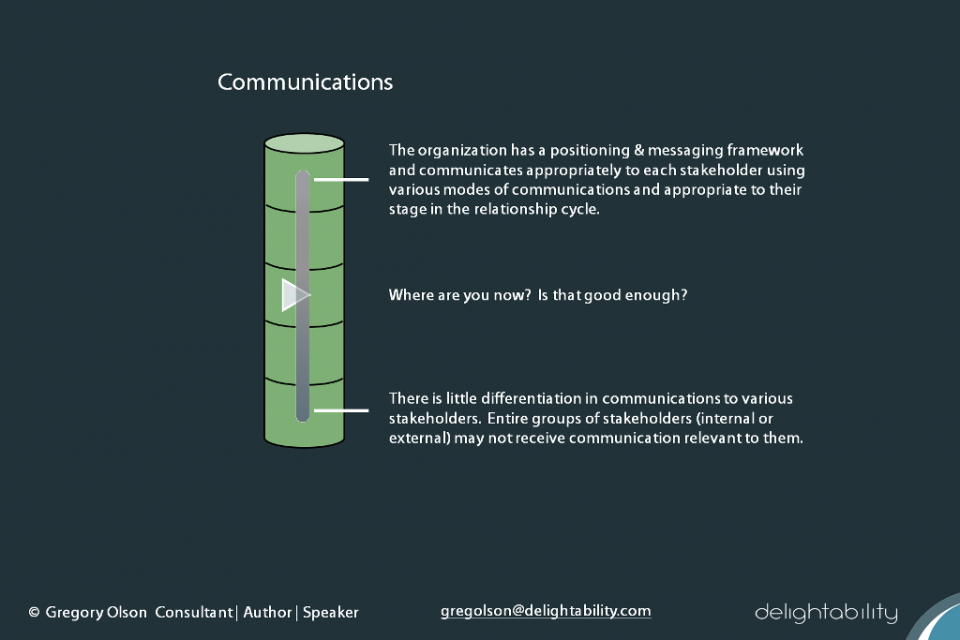Home » Freebies » Choose-Wisely-Using-Performance-Continuums
Chapters in, The Experience Design Blueprint, that especially pertain to this article include:
Chapter 8: The Promise Delivery System
Chapter 9: The Neighborhood
Chapter 11: Barriers to Innovation and Overcoming the Wall
What Do Performance Continuums Reveal About Your Organization?
What Are Business Performance Continuums?
Most any aspect of an organization can be measured along a continuum. Organizations have characteristics that rank them at the top, bottom, or somewhere in between. Leaders have a self awareness of where they would place their organization within each continuum. They also have an opinion of what “good enough” represents for their organization. Performance below the “good enough” line may reveal an uncomfortable performance gap. Closing the gap could significantly improve performance and health of the organization.
A Better Conversation
In business and in life sometimes things are good enough and don’t warrant change. At other times we have an uncomfortable gap between our current reality and our desired future. When I’m working with a client, I like to better understand their current reality as well as their desired future state. We don’t want to wander around in the swamp. So, to make the best use of our time together, I created a tool called the business performance continuums. It reveals important areas of the business; areas where the organization has a problem that is worth solving.
Continuums Provide Guidance for Problems Worth Solving
Whether you are inside the organization or an outside consultant, you want to focus on problems that are of concern. Business performance continuums guide you toward relevant problem areas. You can make a similar tool to use inside your organization. Or, if you are a consultant, to use with your clients. The tool can be a document, a visual, a worksheet or whatever output you’d like. The conversation it represents is more important that the specific output. My own version is an active word template with visual cues that I use as part of a strategic sweep, the process I use with clients for building a dynamic strategic plan.
Steps to Create Your Own Business Performance Continuums:
- Identify the categories that are important to your business
- Describe the high point and low points
- Ask the simple question for each category – where are you now on the continuum?
- Follow that question with – where do you want to be?
- Does the gap between current and desired position cause discomfort? Is this acceptable discomfort or unacceptable discomfort?
- If you closed the gap what would you notice as different?
- Identify and prioritize actions to close the gap(s)
Example: Communications
Below is a deeper look at the communications – business performance continuum. You are either at the top, the bottom, or somewhere in between. For your organization at this time, it might not matter that you rank near the top. Sometimes good enough is actually toward the bottom of the scale for any given category – that is ok.
If there is a small gap (or none) between your current and future states there probably isn’t cause for concern. But, for each continuum where there is a large separation between where you are at, and where you’d like to be, then you’ll want to build a plan to close the gap.
Leaders Spark Better Conversations
If you are part of a leadership team, building performance continuums can be an insightful exercise to reveal the perspective of your colleagues and to communicate your own. The same applies within or across departments. Please note that your answers of course will change over time because the world outside your organization (the business landscape and customer ecosystem) doesn’t sit still. So, good enough today might not be in the future. And, likewise, if you are executing on a plan to close any given gap, you’ll want to re-assess where you’re at in the future. Instead of cause for concern perhaps you’ll have reason to celebrate.
There are no magic tectonic plates at work here; the gap will not close on its own.
The key is to eliminate blind spots that may be limiting the potential of your business. And, if the exercise reveals an uncomfortable gap, then you can choose to do something about it. There are no magic tectonic plates at work here; the gap will not close on its own. Good luck and if you’d like assistance, please contact me. Please also share this article with colleagues to spark a productive conversation.
Discuss Projects
Ready to discuss your needs?




